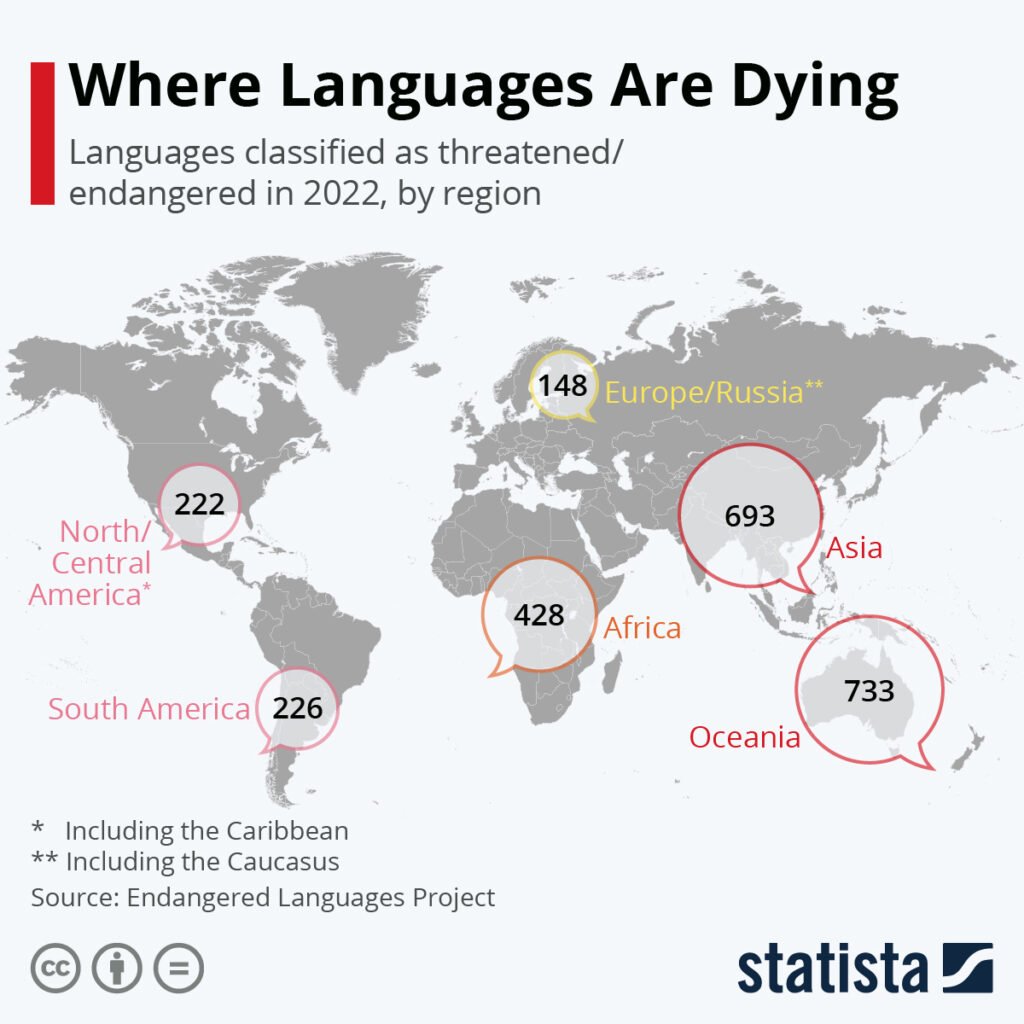Language appears in the enormous fabric of human civilization not only as a tool for communication but also as a deep reflection of identity and culture. However, as the world grows more interconnected, a crisis threatens the extinction of lesser-known languages and cultures and poses a severe challenge to the very foundation of linguistic diversity.
The situation facing lesser-known languages is a stark example of the challenges faced by indigenous groups, such as the Ainu people of Japan. Smaller linguistic systems’ subtleties are marginalized while dominant languages, like English, French, and Spanish, gain prominence due to globalization. This situation is made worse by historical injustices and cultural oppression, which leave a lasting mark on languages that have fallen victim to these. Technological developments also increase the risk of linguistic isolation for communities speaking less well-known languages, making preservation more challenging. The situation of the Ainu people serves as a reminder of the more significant difficulties lesser-known languages and cultures around the world confront. The Ainu language is at a crossroads with fewer and fewer fluent speakers. The Ainu people, who have been historically marginalized and affected by globalization, struggle with the loss of their traditional practices as well as the endangerment of their language. Ainu rights activism, cultural education programs, and language revitalization activities are some measures used to conserve Ainu cultural heritage. Their battle represents the more significant problem that lesser-known languages and cultures worldwide face.
The effects of language extinction are profoundly felt in the structure of identity and culture. Cultural customs, traditions, and oral histories disappear along with languages, disappearing silently from communities’ collective memory. Every language serves as a different lens through which cultures view and communicate their relationship to the outside world, exhibiting the diversity of human expression. Furthermore, the intergenerational transmission of traditional wisdom is hampered by language extinction, a crucial means of passing down information from one generation to the next. This deterioration significantly influences the rich fabric of human culture and heritage, hurts language diversity, and severs a vital link to accumulated knowledge, insights, and cultural nuances.
Potential remedies show promise in the face of the impending language extinction issue. Immersion language programs preserve endangered languages by establishing a living link between language and identity and providing settings where communities can transmit their cultural legacy. In addition, the digital era offers cutting-edge resources, including language preservation platforms, online databases, and digital archives that act as repositories for endangered languages, guaranteeing worldwide accessibility and acting as a virtual haven for linguistic diversity. The Maori people of New Zealand are a prime example of how community-driven activities are crucial to the success of language revitalization. Their bilingual education programs, media representation, and government support contributed to a cultural rebirth. With Te Reo Maori enjoying a resurgence and creating renewed pride and connection to ancestral history, the Maori community is a testament to the persistence and transformative impact of such initiatives in the face of language extinction.
In summary, the disappearance of lesser-known languages and cultures is a natural, pressing problem that requires our combined attention. It is not a far-off or abstract occurrence. It is a significant loss to the cultural diversity that makes up the tapestry of human experience, even beyond its linguistic boundaries. Humanity may set out on a responsible path to preserve linguistic and cultural diversity by understanding the causes and effects of language extinction and actively putting successful revitalization methods into practice. Safeguarding the threads in the rich tapestry of human experience is a joint obligation, not just a task for individual communities. Proactive steps can be taken in the face of this catastrophe to guarantee that the tales buried in lesser-known languages and civilizations will continue to enhance our collective story and that no thread will be lost to the passing of time.
Operation Envoy is a project that aims to help spread awareness and give to people losing their native languages and cultures. Keep an eye out for upcoming VOF articles, and to stay up to date on our project, follow our Instagram account @operationenvoy.
Works Cited
Graham-McLay, Charlotte. “Maori Language, Once Shunned, Is Having a Renaissance in New Zealand.” The New York Times, 16 Sept. 2018, www.nytimes.com/2018/09/16/world/asia/new-zealand-maori-language.html.
Tahara, Kaori. “The Saga of the Ainu Language | the UNESCO Courier.” Courier.unesco.org, courier.unesco.org/en/articles/saga-ainu-language.
Wood, Johnny. “1,500 Endangered Languages Could Disappear by the End of the Century.” World Economic Forum, 5 Jan. 2022, www.weforum.org/agenda/2022/01/languages-endangered-diversity-loss-spoken/.
Woodbury, Anthony. “Endangered Languages | Linguistic Society of America.” Www.linguisticsociety.org, www.linguisticsociety.org/content/endangered-languages#:~:text=The%20pressure%20on%20languages%20can.
